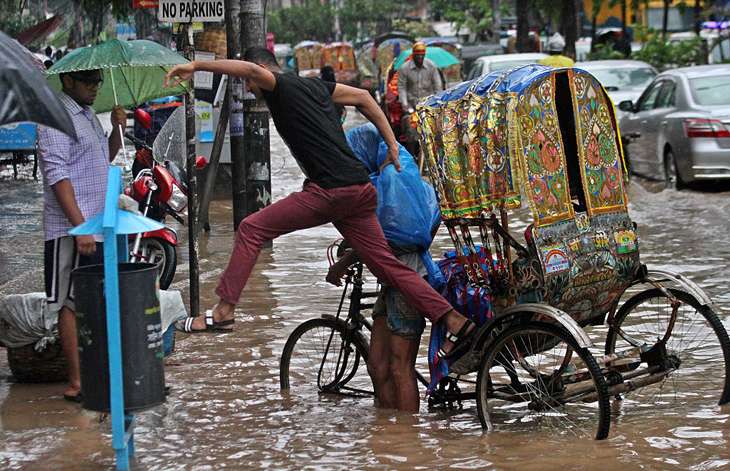World Environment Day: time to wake up and smell the climate change coffee

Whether we close our eyes to it or not, whether we take interest in addressing it or not, the Earth's atmosphere is warming every day, and this process will continue in the coming centuries.
The result will be serious environmental destabilisation and uncertain functioning of the natural ecosystems, signs of which are already clear.
We no longer need meteorologists to say that the average temperature of the Earth's atmosphere is growing steadily. In observing World Environment Day on 5 June, our most urgent task will be to take action towards reduction and reversal of global warming and consequent climate change, and thus, avoid a great threat to the survival of all life forms.
How GHGs have stepped up warming
During the last century, the average temperature of the Earth's surface increased by about 0.7 degrees Celsius. If humanity fails to take appropriate steps, by the turn of the present century, there may be another five degrees Celsius added to this rate of warming.
International scientific opinion, like of the Inter-governmental Panel on Climate Change (IPCC), has linked the warming of the world's atmosphere with the accumulation of excess greenhouse gases (GHGs), like CO2, CH4, CFCs, etc.
The GHGs resist the going out of heat waves from the Earth, creating a blanket effect which was, in a limited context, essential for generating limited warming that helped the emergence of life forms and, later, human civilisations.
However, human civilisations, over the past two centuries or so, contributed to accumulation of enhanced the amounts of GHGs, causing additional heating of the atmosphere.
It was Swedish scientist Helmholtz who linked the process of global warming with the mechanism used in greenhouse farming in very cold regions.
The accumulation of GHGs is resulted from human economic activities like burning of fossil fuels and farming practices based on flood irrigation, commercial cattle farming etc.
The industrial revolution in Europe, followed by post-war rapid economic growth in the industrialised countries, has been the main contributor to the generation of GHGs. In the pre-industrial stage, the level of GHG in the atmosphere was about 275 ppm, which has now increased to about 410 ppm.
The direct result of GHG accumulation is the drastic rise in atmospheric temperatures in most parts of the world that all of us are experiencing.
Biggest threat to survival
April 2016 has been the seventh consecutive warmest month ever for our planet. With humanity causing the biggest threat to the survival of all life forms, global warming has emerged as the most serious warning given by nature to humanity.
A quarter of a century has passed since the Framework Convention on Climate Change (UNFCCC) was accepted by world leaders to take practical steps to mitigate global warming.
However, since then, there have been many Conferences of the Parties (CoP) to the UNFCCC, but an agreement on a long-term process to effectively reduce the GHG level has not been arrived at.
The most recent global conference to find a way out was held in Paris in December, that, in many ways, may be taken as a reversal of the progress made earlier.
There has been a great delay in taking necessary steps, and soon, this would lead to a serious disaster.
Impacts of global warming
In order to understand the urgency in taking steps to reduce and reverse global warming, it will be useful to know about its main impacts on the global environment.
The first and most easily understood change will be the drastic alterations in temperature at local and regional levels. This change will not be uniform in all locations, but will be a rise in most areas and decline in some others, including the oceans.
Such changes will alter the nature of the global circulations of air and moisture, which will alter the climatic conditions and rainfall patterns.

In this regard, the monsoon, which is the most important source of water in India, will be particularly affected.
Preliminary studies on the impacts indicate more intense summer rainfall, increasing floods, reduced winter rainfall, increase in cyclonic events and droughts.
The most serious impact of such climate change would be uncertain flows in rivers and reduced groundwater recharge, making water supply and agriculture very challenging.
The next serious impact of global warming will be the rise of the sea level globally. Rise in atmospheric temperature will warm up the oceans and also alter the biological and chemical processes going on in the oceans.
As a result, there will be thermal expansion of the huge volume of sea water, which will cause a rise in the sea level.
Inside the oceans, there will be serious changes that could lead to decline in marine fishing. The sea level rise will be supplemented by another impact of global warming, rapid melting of the polar ice cap and glaciers.
For South Asia, so dependent on the snow and glacier melts in the Himalayan rivers, this will be a serious blow to water and food security.
In short, humanity better move away from its dependence on the traditional supply patterns of water from the sky and flows in the streams and rivers.
In addition, in the new and warmer climate regime, the spread of new disease patterns will be facilitated, resulting in new types of attacks on human health.
There also could be economic gains from global warming in some parts of the world. In countries or regions where permafrost will melt over extended areas, new landmass would open up for agriculture. Warmer climate in temperate regions would increase plant growth.
The melting of ice around the North Pole will make navigation through that area possible, immensely increasing trade in high latitude areas in the northern hemisphere.
Who should the onus be on?
In May 2016, the world saw the largest weeklong civil disobedience demonstrations spread all over the world, asking for urgent steps to be taken by the leaders of the world to combat global warming and climate change.The land of Mahatma Gandhi, however, did not show much interest in organising any such demonstrations, though reeling under unprecedented high summer temperatures, which touched 55 degrees Celsius in Rajasthan.
Who, then, should take the difficult steps to combat global warming and climate change? The answer is, of course, everyone on Earth, but global action needs to be facilitated mainly through inter-governmental negotiations at a platform like the UNFCCC.
There was an argument that the industrialised countries are responsible for undoing the GHG concentration in the atmosphere. This got known as the 'historical responsibility' of the industrialised countries.
However, there has been no legally binding arrangement to ensure reduction in GHG emissions.
What is even more disappointing, the Paris conference has successfully avoided steps along the argument of 'historical responsibility'. Now the focus has also been on the responsibility of the emission of GHGs in future decades from large and rapidly growing economies, like those of China and India.
This point of view is strengthened by the fact that China is now emitting the greatest volumes of GHGs annually, and plans to do so in the coming several years.
India has also ambitious plans for expansion of coal-based thermal power plants that would emit large volumes of CO2. Fossil fuel-based economy seems to be up for staying on with high coal reserves in China, India and the USA, and the global control of the USA over petroleum.
Complex politics of GHG mitigation
The inordinate delay in taking global steps to mitigate GHG emission has to be seen in the context of national interests, in practice, overtaking global human interests.
In the post-colonial era, the world as a whole followed the path of economic growth as a desirable national objective. Political leaders of all colours are promising economic growth, without making any attempt to assess its diverse costs, social and environmental.
Hence, all nations are taking positions to ensure their own economic growth, while knowing well that the world is becoming more and more unsustainable. This is a perfect example of the tragedy of the global commons.
Global public interest challenge
Reducing and reversing global warming is not merely an environmental agenda of nations. It relates to each and every person living on this planet, and how she or he looks up to the future of humanity.
Mitigation of GHG emission, and hence reversal of all its impacts, is a public interest priority for humanity at the global level.
Accordingly, the creation of a strong global public opinion towards making global inter-governmental platforms, especially the UNFCCC, take legally binding steps for rapid reduction in the GHG level in the atmosphere.
There is an equally strong reason for each inhabitant of planet Earth to change his or her own consumption patterns, so as to drastically reduce GHG emissions.
In large emerging economies, such as China and India, as much in the global south, better quality of life is surely needed. However, whether traditional paths to that lifestyle or an innovative modernism of the South can be designed, has emerged as a great perceptional challenge.Now, religions unite to save the world from climate change
Earth day: The 10 nations most affected by climate change
Climate change may put 1.3 billion people at risk by 2050: World Bank
First published: 3 June 2016, 21:24 IST






![BJP's Kapil Mishra recreates Shankar Mahadevan’s ‘Breathless’ song to highlight Delhi pollution [WATCH] BJP's Kapil Mishra recreates Shankar Mahadevan’s ‘Breathless’ song to highlight Delhi pollution [WATCH]](https://images.catchnews.com/upload/2022/11/03/kapil-mishra_240884_300x172.png)

![Anupam Kher shares pictures of his toned body on 67th birthday [MUST SEE] Anupam Kher shares pictures of his toned body on 67th birthday [MUST SEE]](https://images.catchnews.com/upload/2022/03/07/Anupam_kher_231145_300x172.jpg)






